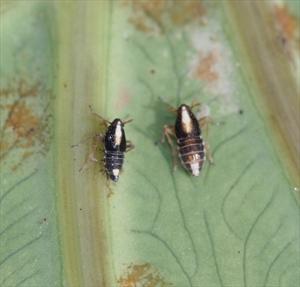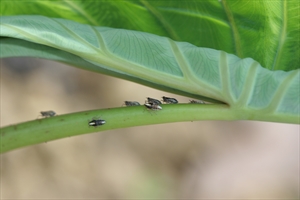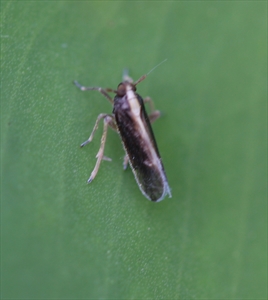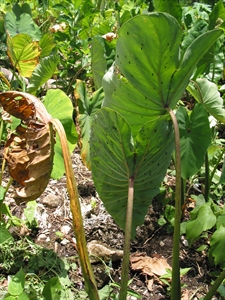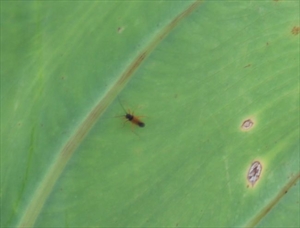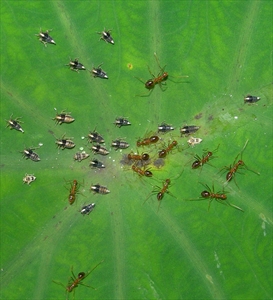Taro planthopper
Pacific Pests, Pathogens, Weeds & Pesticides - Online edition
Pacific Pests, Pathogens, Weeds & Pesticides
Taro planthopper (041)
Tarophagus spp. Previously, only one species was recognised, Tarophagus proserpina. In 1989, a study found there were three: Tarophagus colocasiae, Tarophagus persephone and Tarophagus proserpina.
Southeast Asia, Oceania. Tarophagus colocasiae: Australia, Guam, North America (Hawaii), Northern Mariana Islands, Palau, Solomon Islands; Tarophagus persephone: Australia, North America (Hawaii), Papua New Guinea; Tarophagus proserpina: Cook Islands, Fiji, French Polynesia, New Caledonia, Niue, Papua New Guinea, Samoa, Tonga, and Vanuatu.
Taro; there are records of Tarophagus on Alocasia and Cyrtosperma, but it is not clear which species were involved and whether they were feeding and/or breeding on these hosts.
Damage occurs in two ways:
-
Direct damage: The planthoppers have needle-like mouthparts, which are used to suck sap from taro leaves. When numbers are high, especially in dry weather, leaves wilt and new leaves are stunted. Typically, the leaf stalks bend down so that plants are wider than normal.
-
Indirect damage: Planthoppers spread the viruses associated with alomae and bobone: Colocasia bobone disease rhabdovirus and Taro vein chlorosis rhabdovirus.
Eggs are laid in the midrib of the leaves and in the petioles, often at the base. A slot is cut and 10-20 eggs are placed inside. The eggs hatch after about 15 days. At first, the nymphs are white; later, as they moult - four times, over about 20 days - they become brown and then black with white markings (Photo 1). For most of the time, the adults develop without wings (Photos 2&3). Winged forms appear when the crop matures and/or when the population of planthoppers is high (Photos 4&5). They are about 4 mm long; the wingless ones are shorter.
Heavy rains reduce populations of planthoppers. The youngest nymphs are particularly susceptible to drowning in the water that collects between the petiole bases.
High populations of Tarophagus occur occasionally on taro, especially during dry times. The insects cause water stress by sucking sap from the plants. However, it is not often that Tarophagus is seen in large numbers on taro plants; usually their numbers are controlled by Cyrtorhinus so, apart from times of drought, the overall direct impact of Tarophagus on yield is probably low.
The greater impact of Tarophagus come from it being a vector of taro viruses. It is known that it transmits Colocasia bobone disease rhabdovirus, and that virus is thought to play a key role in alomae, and to be the cause of bobone (see Fact sheet no. 01). It is also likely to be involved in the spread of Taro vein chlorosis virus and the newly discovered tenuivirus. All of these belong to virus groups that are spread by planthoppers.
Look for planthoppers in groups on the underside of leaves, inside those that are beginning to unfurl, and especially between the petioles at the base of the plant. The planthoppers have a characteristic way of moving sideways across the leaf or petiole. Also, nymphs and adults jump if disturbed.
Look for dirty marks on the petioles, especially on the lower parts; the plant sap oozes out as the planthoppers feed and lay eggs, and it hardens as a red-brown crust. This is noticeable when populations are high.
NATURAL ENEMIES
Cyrtorhinus fulvus eats the eggs of Tarophagus species (Photo 6). It is not known how effective Cyrtorhinus is in controlling Tarophagus. During droughts, populations of both are often high. Possibly, rain is the greatest cause of death. Rain often fills the gap between leaf stalks at the base of the plant, drowning the nymphs. Three species of parasites have been reported parasitising eggs and nymphs; and spiders and ladybird beetle larvae also feed on them. However, ants tend the planthoppers, presumably attracted to the honeydew produced as they suck the sap from the leaves (Photo 7). In which case, they may protect them from parasitoids and predators.
CULTURAL CONTROL
Before planting:
- Avoid planting new crops next to those already infested with planthoppers, otherwise the winged forms will easily find the new crops.
- Prepare 'tops' for replanting by cutting off all leaves with dirty marks on them to avoid taking eggs to new gardens in the 'tops'. Making sure that planting material is 'clean' in this way; it is an important method of control.
After harvest:
- Collect and burn or bury all old leaves discarded at harvest.
CHEMICAL CONTROL
Chemical control is rarely needed, except during extended dry periods, when populations can increase to damaging levels. If egg-eating bugs are not present, or are not effective, do the following:
- Use plant-derived products, such as neem, derris or pyrethrum (with the addition of soap). (See Fact Sheet no. 56).
- Alternatively, synthetic pyrethroids are likely to be effective, but will also kill natural enemies.
--------------------
Note, derris (Derris species) contains rotenone, an insecticide, often used as a fish poison; it should be used with caution. The commercial derris insecticide is made from Derris elliptica.
____________________
When using a pesticide (or biopesticides), always wear protective clothing and follow the instructions on the product label, such as dosage, timing of application, and pre-harvest interval. Recommendations will vary with the crop and system of cultivation. Expert advice on the most appropriate pesticide to use should always be sought from local agricultural authorities.
AUTHORS Helen Tsatsia & Grahame Jackson
Information from CABI (2019) Tarophagus proserpina (taro planthopper. Invasive Species Compendium. (https://www.cabi.org/isc/datasheet/52788); and Tasi A, Dale A (2021) Taro planthopper. Featured Creatures, UF/IFAS. (http://entnemdept.ufl.edu/creatures/orn/tarophagus_colocasiae.html#:~:text=The%20taro%20planthopper%2C%20Tarophagus%20colocasiae,tibia%2C%20or%20fourth%20leg%20segment.); and Carmichael A, et al. (2008) TaroPest: an illustrated guide to pests and diseases of taro in the South Pacific. ACIAR Monograph No. 132, 76 pp. (https://lrd.spc.int/about-lrd/lrd-project-partners/taropest); and from Pest Alert (2015) The taro planthopper, Tarophagus colocasiae (Matsumura), a new delphacid planthopper in Florida. FDACS. (https://www.fdacs.gov/ezs3download/download/61789/1413015/Media/Files/Plant-Industry-Files/Pest-Alerts/PEST%20ALERT%20Tarophagus%20colocasiae%20%28Matsumura%29.pdf). Photo 4 Graham Teakle, Canberra.
Produced with support from the Australian Centre for International Agricultural Research under project PC/2010/090: Strengthening integrated crop management research in the Pacific Islands in support of sustainable intensification of high-value crop production, implemented by the University of Queensland and the Secretariat of the Pacific Community.

